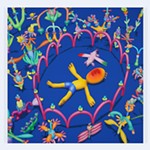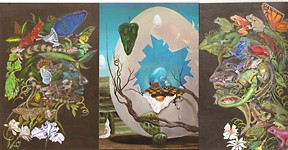"Evolution" at Art.Science.Gallery.
In this group show, each piece leads two lives: one as an artwork, one as a device for sharing information
Reviewed by Sam Anderson-Ramos, Fri., July 1, 2016
In a circa 16th century copperplate engraving by Italian Giulio Cesare Casseri, a man standing on an ocean shore peels the skin free from his own abdomen. The skin is held daintily aloft, revealing intricate veins and bulging intestines. The caption for the plate notes that the illustration depicts the "mesenteries, epigastric arteries, and urachus," among other things. The plate does little to clarify what these things are. While the plate was originally intended to enhance and spread medical knowledge in Renaissance-era Italy, it is better appreciated now as artwork. I don't have to know what a urachus is to be seduced by the image's bizarre and alluring morbidity.
A similar phenomenon is at play in "Evolution" at Art.Science.Gallery., where each piece leads two separate lives: one as an art piece and one as a device for sharing information. Emei Ma's CCR5 Delta 32 features two black tapestries decorated with strands of colored rectangles. The tapestries are compelling for their size, as well as for their melding of traditional fiber aesthetics with a semi-digital effect more common to the internet age. They are even more so after one learns that the strands of color reference a human gene variant "that results in resistance to HIV infection." I'm no kind of scientist, so that quote represents most of what I understood from the piece's explanation. This is to be expected. "Evolution" was curated in conjunction with the recent Evolution 2016 meeting of naturalists and biologists, and therefore is of particular appeal to the science community. But while the piece may function as commentary on the real world implications of HIV medical research, it is also engaging visual drama for those with or without a science background.
More similar to the Casseri anatomical plate are the Meghan Neace prints of insects and crayfish. In Cambarus, two crayfish are rendered from above, as they would be in a naturalist's compendium, and placed on a black background. They are labeled "Cambarus englishi" and "Cambarus halli." Again, much of the accompanying description goes over my head, but this doesn't bother me. The real dedication to science research gives the piece a tangible, and valuable, educational purpose. Cambarus may not wield the conceptual edge that CCR5 Delta 32 does, but it doesn't have to. The variety in "Evolution" provides space for Neace's dynamic illustrations (the intimately detailed crayfish do justice to the naturally entrancing form and hue of the organisms) to be among the stronger pieces on display.
Most deftly striding the line between art and science may be Pippip Ferner's Tunicate anatomy. It is black ink on a troubled yellow background that looks like a storm in a polluted sky. The subject is a tunicate, a kind of invertebrate whose larvae share some physical features with human beings. The real pleasure here is that the artist managed to take this simple idea and turn it into a gyrating cacophony, a monster that somehow resembles an overpopulated tenement building wild with life. Tubes and mechanisms swirl and multiply. It's an obsessive, fantastic mess that generates a wonder equal to that inspired by its more earthly subject matter. Tunicate anatomy, like many of the other pieces here, could thrive, sans description, as complex visual expression. Others exist more effectively as learning tools. Thankfully, we don't have to choose. As with Casseri's puckish corpse, here we may have both.
"Evolution"
Art.Science.Gallery., 916 Springdale #102, 512/522-8278www.artsciencegallery.com
Through July 30













